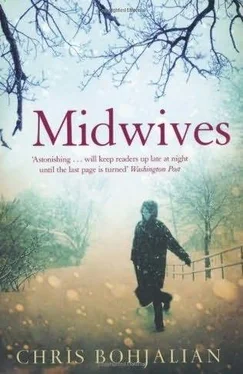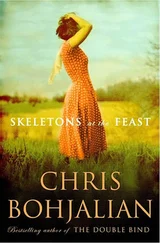Chris Bohjalian - Midwives
Здесь есть возможность читать онлайн «Chris Bohjalian - Midwives» весь текст электронной книги совершенно бесплатно (целиком полную версию без сокращений). В некоторых случаях можно слушать аудио, скачать через торрент в формате fb2 и присутствует краткое содержание. Жанр: Современная проза, на английском языке. Описание произведения, (предисловие) а так же отзывы посетителей доступны на портале библиотеки ЛибКат.
- Название:Midwives
- Автор:
- Жанр:
- Год:неизвестен
- ISBN:нет данных
- Рейтинг книги:5 / 5. Голосов: 1
-
Избранное:Добавить в избранное
- Отзывы:
-
Ваша оценка:
- 100
- 1
- 2
- 3
- 4
- 5
Midwives: краткое содержание, описание и аннотация
Предлагаем к чтению аннотацию, описание, краткое содержание или предисловие (зависит от того, что написал сам автор книги «Midwives»). Если вы не нашли необходимую информацию о книге — напишите в комментариях, мы постараемся отыскать её.
Midwives — читать онлайн бесплатно полную книгу (весь текст) целиком
Ниже представлен текст книги, разбитый по страницам. Система сохранения места последней прочитанной страницы, позволяет с удобством читать онлайн бесплатно книгу «Midwives», без необходимости каждый раз заново искать на чём Вы остановились. Поставьте закладку, и сможете в любой момент перейти на страницу, на которой закончили чтение.
Интервал:
Закладка:
– from the notebooks of Sibyl Danforth, midwife
WHEN THINGS GO WRONG in obstetrics, they go wrong fast. They fall off a cliff. One minute mom and fetus are happily savoring the view from the top, and the next they're tumbling over the edge and free-falling onto the rocks and trees far below.
I would hear physicians use those sorts of analogies all the time when I was growing up. And of course virtually every ob-gyn the State paraded before the jury when my mother was on trial had his or her personalized version of the labor-as-aerial-act speech.
"Most of the time, labor is like going for a drive in the country. Nothing unusual will occur. But sometimes-sometimes-you'll hit that patch of black ice and skid off the road, or a dump truck will lose control and skid into you."
"The vast, vast majority of the time, labor doesn't demand any medical intervention. It's a natural process that women have been handling since, well, since the beginning of time. But we've lost our collective memory of the fact that although labor is natural, it's dangerous. Let's face it, there was a time when women and babies died all the time in labor."
Their point was always the same: Women should not have their babies at home with my mother. They should have them in hospitals with physicians.
"A hospital is like an infant car seat: If something unexpected should occur and there's some kind of collision, we have the tools to pull the baby out of the oven," one doctor insisted, mixing metaphors and mistaking a uterus for a kitchen appliance from Sears.
In the late 1970s and early '80s, my mother was one of a dozen independent or "lay" midwives in Vermont who delivered babies at home. Virtually no doctors did. The cost of malpractice insurance for home birth was prohibitive, and most ob-gyns really believed it was safer to bring children from womb to world in a hospital.
My mother disagreed, and she and different doctors often waged their battles with statistics. As a little girl I would hear phrases and numbers rallied back and forth like birdies on badminton courts, and I was fascinated by the grimness behind the very clean, clinical-sounding words. Maternal morbidities. Neonatal mortalities. Intrapartum fatalities.
The word stillborn fascinated me. Still born. At nine or ten, I assumed it conveyed a purgatory-like labor, a delivery that went on forever.
"Is he still being born?"
"Indeed, he is. Horrible, isn't it? They're now in their third year of labor…"
My mother believed that home birth was safe at least in part because she refused to deliver any high-risk pregnancies at home. Women with very high blood pressure, for example. Diabetes. Twins. She insisted on hospital birth for those women, even when they pleaded with her to help them have their babies at home.
And she never hesitated to transfer a laboring mother in her care to the hospital, if something was-as she once described the feeling to me-making her heart beat a little faster than she liked. Sometimes it would be due to my mother's sense that the labor hadn't progressed in hours, and her patient was exhausted. Sometimes my mother might recommend a transfer because she feared a more dangerous turn was imminent, one of those things the medical community euphemistically describes as an "unforeseen occurrence": the placenta separating from the uterine wall before the baby has arrived or such signs of fetal distress as a falling heartbeat.
In all of the years that my mother practiced, the records would reveal, just about four percent of the time she took her laboring women and went to the hospital.
There's no question in my mind that my mother and the medical community disliked each other. But she would never have let their conflicts jeopardize the health of one of her patients. That's a fact.
I could begin my mother's story with Charlotte Fugett Bedford's death, but that would mean I'd chosen to open her life with what was for her the beginning of the end. It would suggest that all that mattered in her life was the crucible that made my family a part of one tragic little footnote to history.
So I won't.
Besides, I view this as my story, too, and why I believe babies became my calling as well.
And I am convinced that our stories began in the early spring of 1980, a full eighteen months before my mother would watch her life unravel in a crowded courtroom in northern Vermont, and at least a full month before the Bedfords would even arrive in our state.
Here's what I recall: I recall that the mud was a nightmare that year, but the sugaring was amazing. That's often the case. If the mud is bad, the maple will be good, because mud and maple are meteorological cousins of a sort. The kind of weather that turns dirt roads in Vermont into quicksand in March-a frigid, snowy winter, followed by a spring with warm days and cold, cold nights-also inspires maple trees to produce sap that is sweet and plentiful and runs like the rivers swollen by melted snow and ice.
My mother's and father's families no longer sugared, and so my memories of that March revolve more around mud than maple syrup: For me, that month was largely an endless stream of brown muck. It covered my boots to my shins in the time it would take to trudge fifty yards from the edge of our once-dirt driveway to the small cubbyhole of a room between the side door and the kitchen, which earned its name as a mudroom in those days: The floors and walls would be caked with the stuff. When the mud was wet, it was the dark, rich color of tobacco; when it dried, the color grew light and resembled the powder we used then to make chocolate milk.
But wet or dry, the mud was everywhere for two weeks in the March of 1980. The dirt roads became sponges into which automobiles were constantly sinking and becoming stuck, sometimes sinking so deep that the drivers would be unable to open their doors to escape and would have to climb through the car windows to get out. Yards became bogs that slowed running dogs to a walk. Virtually every family in our town had laid down at least a few long planks or wide pieces of plywood to span the puddles of mud on their lawns or to try and link the spot of driveway on which they parked their cars with their front porches.
My mother parked her station wagon just off the paved road at the end of our driveway, as she did often in the winter and early spring, to ensure that she could get to her patients in a timely fashion. Nevertheless, there were still those occasional births when even my determined mother was unable to get there in time. The section of our old house she used as her office had one whole wall filled with photos of the newborn babies she'd delivered with their parents, and one of those snapshots features a baby crowning while the mother is attended by her sister. The sister is pressing a telephone against her ear with her shoulder while she prepares to catch the child. My mother is at the other end of that telephone, talking the sister through the delivery since a snowstorm had prevented either her or the town rescue squad from getting to the laboring woman before the baby decided it was time to arrive.
That spring, even a city with nothing but paved streets and solid sidewalks like Montpelier-the state capital-somehow developed sleek coats of mud on its miles and miles of asphalt and cement.
But the sugaring was good and the syrup crop huge. My best friend Rollie McKenna had a horse, and although the two of us were never supposed to ride her at the same time, we did often, and that March we rode up to the Brennans' sugarhouse after school at least three or four times so we could smell the sweet fog that enveloped the place as Gilbert and Doris slowly boiled the sap into syrup.
Of course, there were other reasons for riding into the hills where the Brennans had hung hundreds and hundreds of buckets on maple trees. We also rode there because the roads we took to the sugarhouse would lead us past the town ball field where Tom Corts and his friends would smoke cigarettes.
Читать дальшеИнтервал:
Закладка:
Похожие книги на «Midwives»
Представляем Вашему вниманию похожие книги на «Midwives» списком для выбора. Мы отобрали схожую по названию и смыслу литературу в надежде предоставить читателям больше вариантов отыскать новые, интересные, ещё непрочитанные произведения.
Обсуждение, отзывы о книге «Midwives» и просто собственные мнения читателей. Оставьте ваши комментарии, напишите, что Вы думаете о произведении, его смысле или главных героях. Укажите что конкретно понравилось, а что нет, и почему Вы так считаете.











